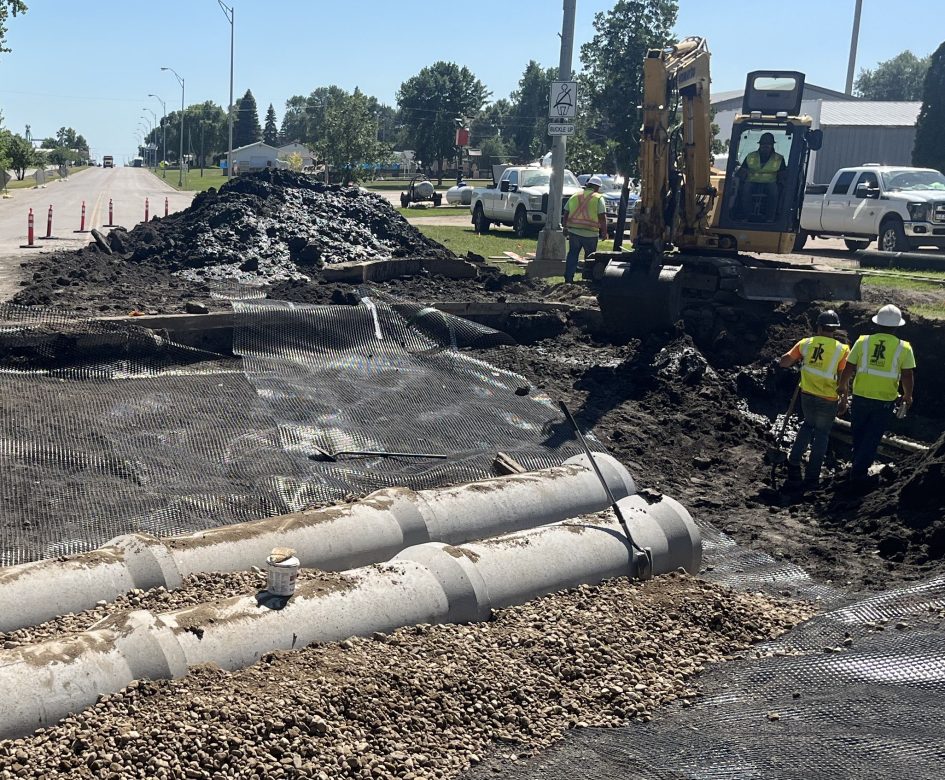The aging infrastructure in Larimore, North Dakota suffered from an all-too-common issue – deferred maintenance that led to deteriorating water mains, failing sewer systems, and poor road conditions. A comprehensive citywide infrastructure improvement project completed in 2024 updated water mains, sanitary and stormwater sewer systems, plus roadways. The American Council of Engineering Companies of North Dakota recognized the City of Larimore’s project with a 2024 Engineering Excellence Award in the Special Projects category.
Larimore’s leadership knew something needed to be done when homeowners began experiencing more frequent sewer backups, and AE2S discovered the City was losing 50% of its treated water due to leaks in the water mains. The condition of the sewer system was so severe that some sections functioned as underground open channels. Additionally, the City’s flat topography caused persistent drainage and nuisance flooding issues, particularly around key areas like the fire station and elementary school.
Recognizing the critical need for intervention, Larimore embarked on an ambitious, citywide infrastructure reconstruction project. AE2S led the planning, analysis, and design phases, culminating in a 2018 bid opening. Although the bids were favorable, the City pursued outside funding to offset the estimated project cost of $13 million to $15 million. Over the next two years, AE2S helped the City secure over $4 million in grants and additional funding through State programs, USDA loans, and special assessments. With this financial backing, the project was rebid in January 2021, and in February, the City Council approved the low bid of $14.1 million from JR Civil for the underground utility work portion of the project.
JR Civil’s portion of the project took two years to complete and included the replacement of 46,000 feet of water main, 45,000 feet of sanitary sewer, and installation of 21,000 feet of new storm sewer. After completion of the underground portion of the project, the City of Larimore decided to proceed with paving the streets. The street project was bid March of 2023 and Strata Corporation was the low bidder with a bid of approximately $7.6 million. That project included salvaging the top four to five inches of gravel and installing bituminous pavement throughout town. The paving project was substantially completed in the Fall of 2023. During the summer of 2024, contractors worked to finish up some warranty items and finish restoration and punch list items.
One of the most unique features of the citywide infrastructure improvements project is the use of cloud-based GIS (Geographic Information System) and VRS (Virtual Reference Station) technology to provide precise, real-time mapping of existing utilities. The innovative tool allowed the project team to accurately document, track project status, effectively communicate onsite construction questions to key stakeholders, and manage the City’s utility network during construction, which minimized disruptions and utility breaks. It also provided the City with a valuable dataset for future infrastructure management.
By incorporating real-time field-to-office workflows and high accuracy data collection directly into a cloud-based GIS platform, ArcGIS Online, complete and precise mapping was achieved, as well as project transparency, efficient utility management, and the creation of a valuable tool for future maintenance. The two-phased approach— first addressing the underground utility work and backfilling with gravel, allowed the trenches and disturbed ground to settle properly, ensuring higher quality roads to best accommodate the paving project.
The integration of storm sewer upgrades addressed long-standing drainage issues, further extending the lifespan and resilience of the City’s infrastructure. Throughout the process, AE2S field staff monitored progress onsite, documented construction activities, and collected GPS locations directly into the high accuracy mapping GIS solution. The data was immediately utilized for other projects, including the Lead Service Line Inventory for the Revised Lead and Copper Rule, and utility staking for a nearby gas pipeline project.
AE2S also played a pivotal role in educating the public about the project’s need, costs, and long-term benefits. By assisting the City of Larimore’s staff by writing and disseminating news releases to the local newspaper prior to a public vote, organizing public meetings, and writing articles, the need for the project and potential costs were communicated thoroughly and effectively.
The Larimore project illustrates how a comprehensive infrastructure improvement plan, even in smaller communities, can be accomplished with strategic use of technology, funding, and public outreach. The utilization of GIS for small-town infrastructure, combined with innovative phasing of work, redefines how rural municipalities can address large-scale infrastructure challenges, proving that technology is accessible and impactful for all community sizes.
By modernizing Larimore’s water, sewer, and stormwater systems, the project improved the health and safety of residents. Replacing deteriorating sewer lines reduces the risk of contamination and protects public health, while the stormwater improvements mitigate flooding risks in vulnerable areas. The City of Larimore has not only improved its infrastructure; it also created a solid foundation for future growth and sustainability.
In the third quarter edition of AE2S & Beyond, another ACEC ND Engineering Excellence Award-winning project will be featured. The McKenzie County Water Resource District (MCWRD) System IV Part IV Project won the Surveying and Mapping Technology category.

